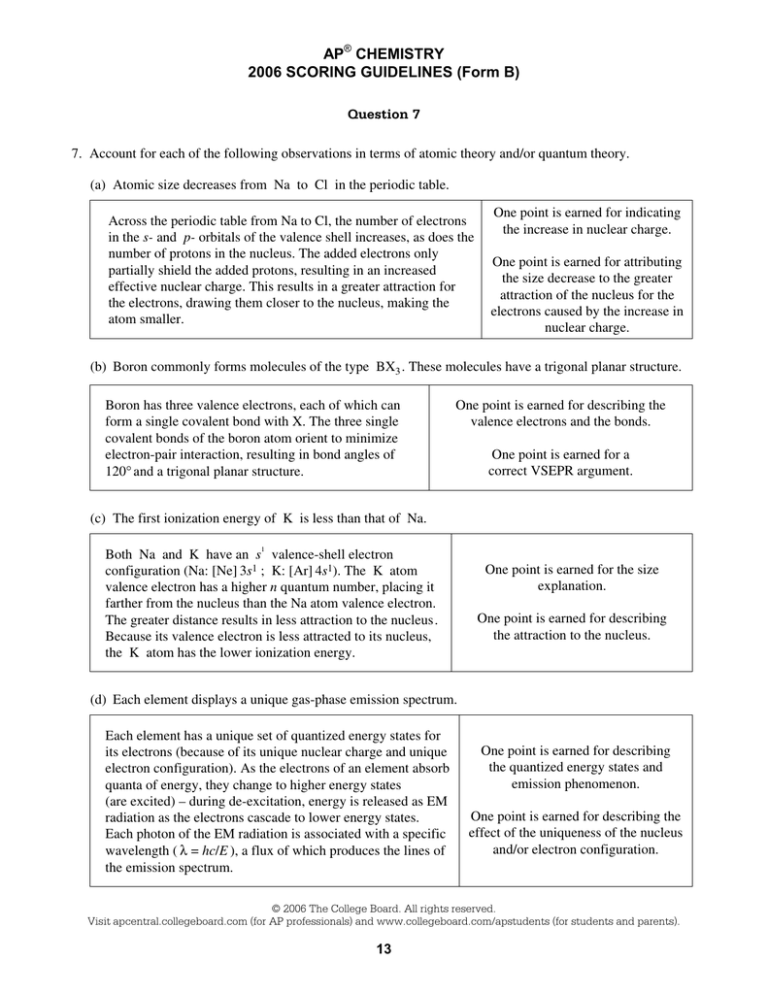
AP® CHEMISTRY
2006 SCORING GUIDELINES (Form B)
Question 7
7. Account for each of the following observations in terms of atomic theory and/or quantum theory.
(a) Atomic size decreases from Na to Cl in the periodic table.
Across the periodic table from Na to Cl, the number of electrons
in the s- and p- orbitals of the valence shell increases, as does the
number of protons in the nucleus. The added electrons only
partially shield the added protons, resulting in an increased
effective nuclear charge. This results in a greater attraction for
the electrons, drawing them closer to the nucleus, making the
atom smaller.
One point is earned for indicating
the increase in nuclear charge.
One point is earned for attributing
the size decrease to the greater
attraction of the nucleus for the
electrons caused by the increase in
nuclear charge.
(b) Boron commonly forms molecules of the type BX3 . These molecules have a trigonal planar structure.
Boron has three valence electrons, each of which can
form a single covalent bond with X. The three single
covalent bonds of the boron atom orient to minimize
electron-pair interaction, resulting in bond angles of
120° and a trigonal planar structure.
One point is earned for describing the
valence electrons and the bonds.
One point is earned for a
correct VSEPR argument.
(c) The first ionization energy of K is less than that of Na.
1
Both Na and K have an s valence-shell electron
1
configuration (Na: [Ne] 3s ; K: [Ar] 4s1). The K atom
valence electron has a higher n quantum number, placing it
farther from the nucleus than the Na atom valence electron.
The greater distance results in less attraction to the nucleus.
Because its valence electron is less attracted to its nucleus,
the K atom has the lower ionization energy.
One point is earned for the size
explanation.
One point is earned for describing
the attraction to the nucleus.
(d) Each element displays a unique gas-phase emission spectrum.
Each element has a unique set of quantized energy states for
its electrons (because of its unique nuclear charge and unique
electron configuration). As the electrons of an element absorb
quanta of energy, they change to higher energy states
(are excited) – during de-excitation, energy is released as EM
radiation as the electrons cascade to lower energy states.
Each photon of the EM radiation is associated with a specific
wavelength ( λ = hc/E ), a flux of which produces the lines of
the emission spectrum.
One point is earned for describing
the quantized energy states and
emission phenomenon.
One point is earned for describing the
effect of the uniqueness of the nucleus
and/or electron configuration.
© 2006 The College Board. All rights reserved.
Visit apcentral.collegeboard.com (for AP professionals) and www.collegeboard.com/apstudents (for students and parents).
13
© 2006 The College Board. All rights reserved.
Visit apcentral.collegeboard.com (for AP professionals) and www.collegeboard.com/apstudents (for students and parents).
© 2006 The College Board. All rights reserved.
Visit apcentral.collegeboard.com (for AP professionals) and www.collegeboard.com/apstudents (for students and parents).
© 2006 The College Board. All rights reserved.
Visit apcentral.collegeboard.com (for AP professionals) and www.collegeboard.com/apstudents (for students and parents).
© 2006 The College Board. All rights reserved.
Visit apcentral.collegeboard.com (for AP professionals) and www.collegeboard.com/apstudents (for students and parents).
© 2006 The College Board. All rights reserved.
Visit apcentral.collegeboard.com (for AP professionals) and www.collegeboard.com/apstudents (for students and parents).
© 2006 The College Board. All rights reserved.
Visit apcentral.collegeboard.com (for AP professionals) and www.collegeboard.com/apstudents (for students and parents).
AP® CHEMISTRY
2006 SCORING COMMENTARY (Form B)
Question 7
Sample: 7A
Score: 7
This response earned 7 out of 8 possible points: 2 points for part (a), 2 points for part (b), 2 points for part (c), and 1
out of 2 possible points for part (d). The second point was not earned in part (d) because the response does not
explain the relationship between energy levels and emission.
Sample: 7B
Score: 6
The points were not earned in part (d) because differences in emission spectra are attributed to differences in
mass and number of protons. There is no mention of electron energy states or transitions among them.
Sample: 7C
Score: 3
In part (b) 1 point was earned for noting that compounds of the type BX3 do not have lone pairs of electrons,
resulting in a trigonal planar structure. However, the second point was not earned because there is no explanation
as to why boron forms compounds of the type BX3 . In part (c) no points were earned because even though the
definition of ionization energy is correct, the response only states what the trend is and does not explain why the
trend exists. In part (d) no points were earned because differences in emission spectra are incorrectly attributed to
differences in root-mean-square speed.
© 2006 The College Board. All rights reserved.
Visit apcentral.collegeboard.com (for AP professionals) and www.collegeboard.com/apstudents (for students and parents).


